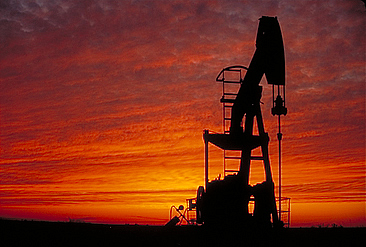Oil fields in the Osage Nation are in a mature stage of depletion, yet millions of barrels of potentially recoverable bypassed oil remain in the Bartlesville sandstone, a shallow, low-permeability, naturally fractured reservoir. Conventional waterfloods using vertical wells in this formation are often unsuccessful because water cannot be injected below the reservoir parting pressure at a volume high enough to improve oil recovery. Channeling and poor oil recovery are typical if the fracture-parting pressure of the reservoir is exceeded. By using horizontal injection wells, large volumes of water can be injected below this parting pressure and a substantial amount of additional oil can be recovered. This project utilized horizontal wells and secondary recovery techniques to demonstrate that improved oil recovery could be achieved from an abandoned reservoir.
Project Results
Three horizontal wells (one water injector straddled by two producers) were drilled in a heel-to-toe configuration in Wolco field. Waterflooding this configuration resulted in uneconomic, low oil recovery (8 barrels of oil per day) and high water production (700 barrels of water per day).
Analysis of the pilot showed that the two horizontal producing wells were drilled into a zone with near-residual oil saturation. A spinner survey of the horizontal injector well indicated that water was entering the formation through a mere 15 foot heel section of the injection well. With the new information from the pilot, the two horizontal producing wells were re-drilled in the opposite direction and positioned 10 feet from the top of the formation where the oil saturation was higher. An existing well, located near the toes of the producers, was converted into a vertical injector with the injected fluid going into a high permeability zone lower in the formation.
Oil recovery increased to 15 barrels per day, while water production was slashed to 135 barrels per day, making this waterflood economic. It was concluded that abandoned fields can become economic if adequate oil saturations exist, along with an attractive combination of bottomhole pressure, permeability, and the proper placement of horizontal wellbores.
Benefits
The primary benefit of this project is to prove the concept that horizontal wells can be used to reestablish economic oil production in old fields that are scheduled to be plugged and abandoned. The performance of the horizontal injection well proved that large volumes of water can be injected below parting pressure in the tighter reservoirs found in northeast Oklahoma. The results will serve as a guide for other operators and allow them to reconsider the value of poorly performing waterfloods in light of the low-cost horizontal technology demonstrated by this project.
Project Summary
This three-year project tested horizontal waterflooding as a means of improving oil recovery from the Middle Pennsylvanian Bartlesville Formation in Wolco field. Three horizontal wells were drilled-an injector surrounded by two producer wells-arranged in a heel-to-toe configuration to minimize heel-to-heel interaction between the injection well and the horizontal producers.
The selection of Wolco field for the pilot location was based on cumulative oil production, remaining recoverable reserves, reservoir characteristics, and available infrastructure. Numerical simulations were conducted to determine whether project economics were favorable.
Although Wolco field had never been waterflooded, the nearby North Avant Unit had showed early water breakthrough from high water-injection rates that exceeded the fracture parting pressure. This knowledge was used to design injection rates below the fracture parting pressure.
The Bartlesville Formation was deposited in a fluvial incised valley and ranges from braided fluvial deposits in the formation's lower zone to meandering fluvial deposits in the upper portion of the reservoir. In the pilot area, the sandstone is 80 feet thick, with an average permeability of 20 millidarcies and porosities ranging from greater than 20% in the lower zone to 15-20% in the upper zone. The formation is fractured, with surface fractures dominantly oriented N35E.
Simulation studies indicated that the horizontal injection wells be drilled 20 feet from the bottom of the sand, with the two producing wells 20 feet from the top of the sand. The horizontal wells were drilled parallel to the suspected prevailing fracture orientation within the field.
The wells were drilled with a curve-drilling assembly configured to drill a 70-foot radius curve. A lateral drilling assembly was used to drill the horizontal section of the wells. The vertical part of the wells was drilled with air, the short-radius curve with water, and the lateral section of the wells with air/foam to minimize formation damage.
During water injection, water breakthrough was accompanied by disappointingly low oil production-8 barrels per day-and high water production at 700 barrels per day. A spinner survey run in the injection well indicated that all injected fluids were entering the formation within only a 15-foot section of the well. Well-log surveys on both producing wells suggested that the laterals were drilling too deep and should be nearer the top of the formation, where oil saturation was higher.
Re-drilling the producing wells in the opposite direction closer to the top of the formation and converting an existing well located near the toes of the producers into a vertical injector increased oil production to 15 barrels per day, making the project economical.
Due to the success of the reconfiguration, other opportunities to apply the technology were considered. A series of workovers, cased-hole logs and bottom-hole pressure measurements were conducted on the adjacent lease to the east of the project area. The information gathered indicated the potential for recovering additional oil.
Wells #325 and 328, originally drilled and completed in 1914, were re-entered and drilled horizontally. They have responded favorably, with a combined production of approximately 40 BOPD and 600 BWPD. This is significant, considering the age of the wells and that this portion of the field has been shut in since the 1980s.




